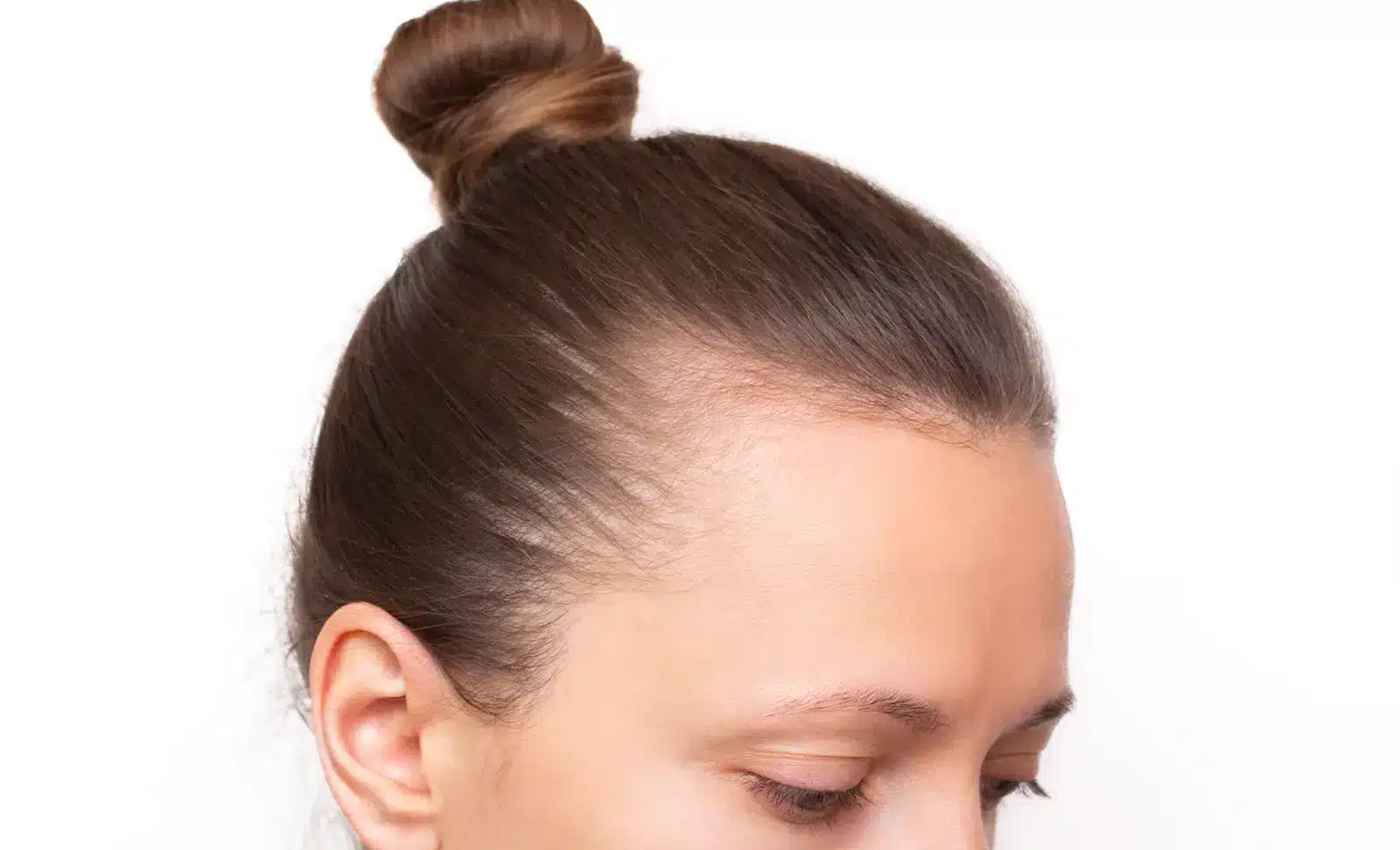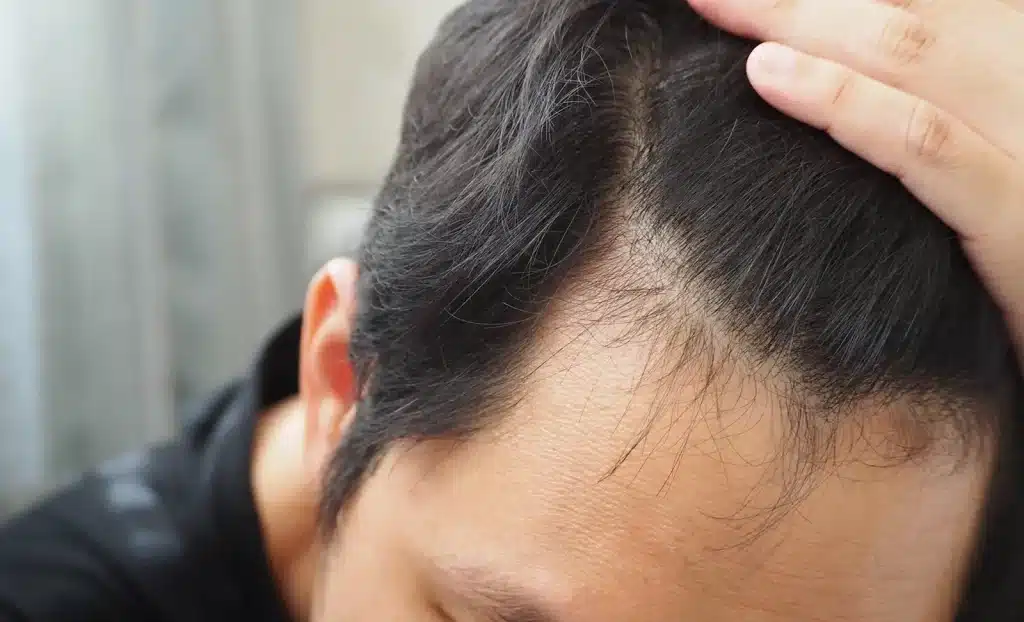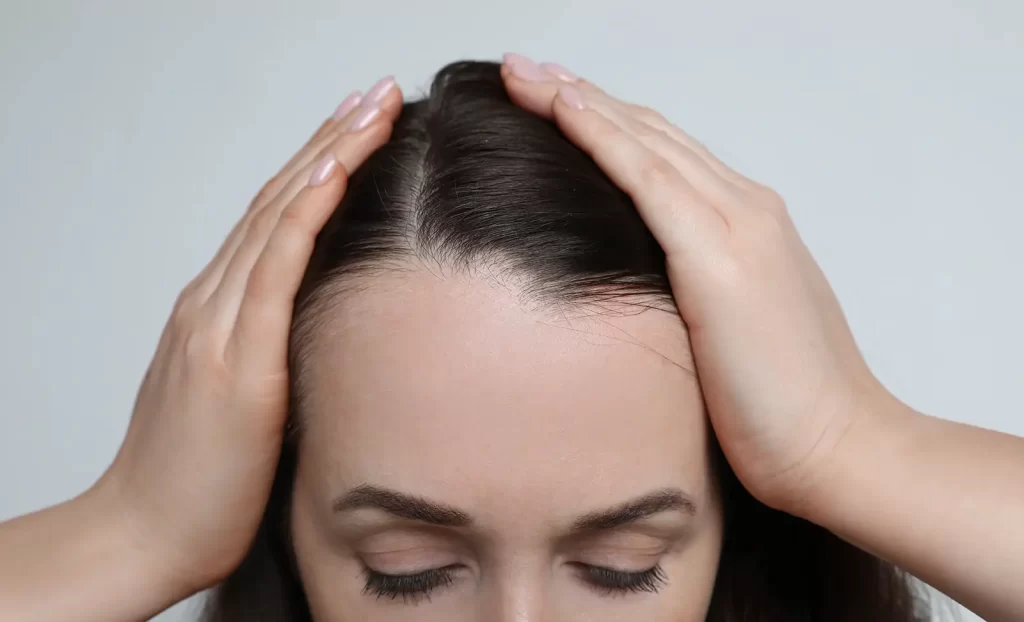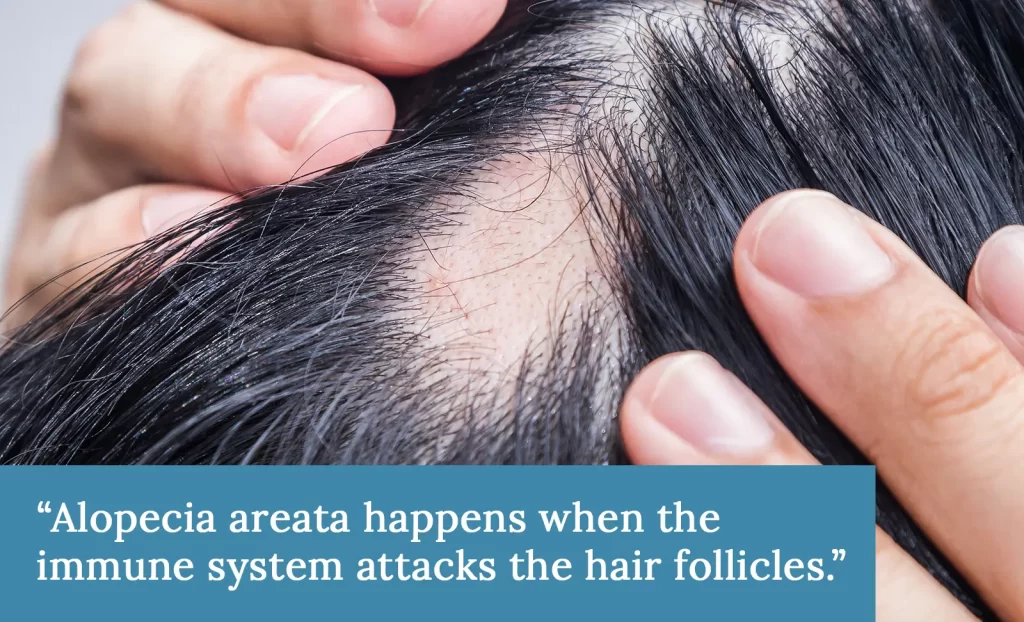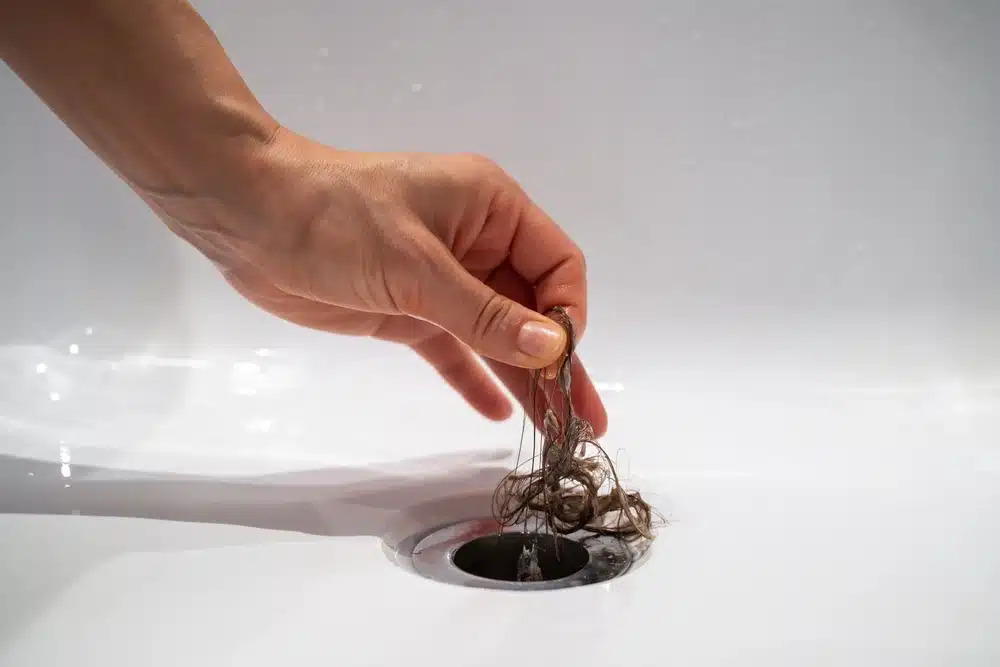Hair thinning on one side is usually an indication of a specific type of hair loss called traction alopecia. However, other causes may be at play, such as androgenetic alopecia. Hair thinning on one side is typically reversible, especially when using hair restoration treatments like minoxidil or finasteride.
- Why Does the Hair Thin Only On One Side?: There are many potential causes of this. Most of the time, it’s due to something called traction alopecia, which is when too much pulling on the hair follicles causes hair loss. This can be caused by sleeping in certain positions or wearing a specific hairstyle.
- What Are the Best Hair Treatments for Hair Thinning on One Side?: Hair loss medications like finasteride or minoxidil can be effective at regrowing hair only on one side. However, if the hair loss is due to dead hair follicles caused by traction alopecia, you may want a more targeted solution like a hair transplant.
- Is Traction Alopecia Permanent?: It depends. If traction alopecia is caught early, the hair follicles may only be dormant rather than dead and able to be revived. However, traction alopecia can lead to the destruction of hair follicles. In this situation, a hair transplant is necessary for the person to regrow hair in that area.
Have you noticed your hair is thinning more on one side? Losing your hair on one side can be worrisome, but remember that it is very common and has several potential causes.
The first step to treating hair thinning on one side is understanding why it’s happening, so in this article, learn all the different causes and treatments to help you regrow a full head of hair once more.
The Causes of Hair Thinning on One Side
If you notice hair thinning more on one side, you will want to treat it as soon as possible to prevent further hair loss, which means understanding exactly what’s happening. So, here are some of the most common causes of one side of the scalp thinning.
Traction Alopecia
Traction alopecia is a specific type of hair loss caused by damage to the hair follicles. This occurs when there is repeated pulling or stretching of the hair follicles, often due to too-tight hairstyles like braids, cornrows, or pulled-back ponytails. It can also occur when someone consistently wears hair weaves or hair extensions.
Unfortunately, traction alopecia can lead to permanent scarring and damage, meaning the hair can no longer grow back. This is why catching the signs of traction alopecia early – such as spotting hair loss on one side – is so important.
Androgenetic Alopecia
Androgenetic alopecia is an extremely common cause of hair loss, affecting both men (male pattern baldness) and women (female pattern baldness). It is a hereditary type of hair loss, meaning you are more likely to experience it if your parents have lost their hair.
The symptoms in men and women differ slightly; [1] men tend to lose their hair from the temples (forming an M-shaped hairline) and their crowns. On the other hand, women tend to lose their hair from the top of the head, and it appears as more general thinning.
In some cases, androgenetic alopecia can occur on one side first – for example, you might notice thinning at the temples on one side.
Androgenetic alopecia does not reverse on its own, but there are some treatment options, such as hair medications and clinical treatments, which we’ll go into further below.
Telogen Effluvium
Telogen effluvium is a type of hair loss that occurs rapidly, causing the hair to shed around the top of the head, sometimes more on one side than the other. It is caused by some stressor, with potential triggers including: [2]
- Fever
- Childbirth
- Psychological Stress
- An Infection
- Not Getting Enough Protein
Certain Medications
The good news is that telogen effluvium is temporary – assuming the stressor is treated, the hair should grow back as before.
Alopecia Areata
Another medical condition that could cause thinning on one side is alopecia areata. Alopecia areata is a type of hair loss that causes patchy hair loss on the scalp and the rest of the body, and you could find more patches on one side of the scalp than on the other. The hair loss usually creates small, smooth, circular patches.
Alopecia areata happens when the immune system attacks the hair follicles. [3] There is no current cure, but there are treatment options that can help manage the hair loss.
Scalp Issues
Your scalp and hair are intrinsically linked – after all, your hair grows from your scalp. As such, it’s highly possible for one-sided hair loss to be caused by some scalp issue.
Several scalp problems could cause this, including seborrheic dermatitis, scalp psoriasis, scalp infections, and ringworm.
Trichotillomania
Trichotillomania is a mental health condition that causes a person to pull strands of their hair compulsively, causing hair loss. The individual may want to stop but cannot, and it may even happen subconsciously.
If someone with trichotillomania predominantly pulls out their hair from one side of the head, this can lead to hair loss on that side.
Sleeping Position
Did you know that even your sleeping position could contribute to hair loss? It is true. While it’s unlikely to cause significant hair loss, consistently sleeping on one side could cause excess pressure on the follicles, leading to thinning. The best way to prevent this is by investing in a silk or satin pillow, never sleeping with wet hair, brushing your hair before sleep, and wearing a protective hairstyle.
Medications
Certain medications cause hair loss, which could affect just one side, at least to begin with. Some medications that may affect the hair include blood thinners, hormonal medications, chemotherapy drugs, antidepressants, blood pressure medications, and anticonvulsants. If you think a medication you are taking is causing hair loss, speak to your doctor.
Nutritional Deficiencies
Some nutritional deficiencies contribute to hair loss. These include [4] B vitamins, C, D, E, A, iron, zinc, and selenium. You cannot diagnose yourself with a nutritional deficiency on your own – if you think you have a deficiency, book an appointment with your doctor, as you’ll need to get your blood work done. Taking a supplement is typically the best solution if a nutritional deficiency is causing your hair to thin on one side.
Any of these options could be causing your hair loss on one side – if you’re unsure which, speak to a hair specialist, doctor, or dermatologist.
Interested in treating your hair loss? Download our revolutionary hair track app, which lets you monitor your hair loss/growth and get in touch with hair experts.
Is Hair Thinning on One Side Reversible?
Oftentimes, yes – you can find a hair loss treatment to treat a variety of causes. Of course, that depends on the exact cause of your hair thinning, with some causes being easier to treat than others. For example, it is easier to treat a nutritional deficiency through supplements, but treating androgenetic alopecia may be more challenging (although certainly not impossible).
Treating Hair Thinning On One Side
Are you ready to regrow your hair? You do not have to live with hair loss when treatments like the following are available.
Minoxidil
Minoxidil is an over-the-counter hair restoration medication you apply topically, and it works best for those with androgenetic alopecia. It works by opening the blood vessels on the scalp, increasing blood flow, and activating the follicles so that they grow newer, thicker hair.
Finasteride
Finasteride is another hair loss medication, but it is for men only. It’s an oral medication that prevents the production of DHT, a male hormone that contributes to hair loss. You need a prescription to get finasteride, and it’s not available on the NHS for hair restoration.
PRP Injections
PRP (platelet-rich plasma) is an in-clinic treatment that involves harvesting a patient’s blood and extracting specific platelets. These platelets are then used in injections that are applied directly to the scalp. It helps hair growth due to the growth factors within the blood, which help stimulate the follicles.
Corticosteroids
Corticosteroids help treat hair loss caused by autoimmune conditions, such as alopecia areata. They work by reducing inflammation and regulating the immune system, which helps prevent the immune system from attacking the follicles, allowing new hair to grow. You can only get corticosteroids through a prescription, so speak to your doctor about this treatment option.
Low-level Laser Therapy
Low-level laser therapy is a hair treatment you can get in a clinic or alone at home (if you have the right home device). It’s a process involving low-level lasers directed at the area experiencing hair loss. It works by stimulating ATP (adenosine triphosphate) production, [5] which improves cell function. This repairs tissue and improves blood flow to the scalp, facilitating new growth.
Hair Transplants
A hair transplant is one of the best hair restoration solutions for anyone with androgenetic alopecia, especially if other treatments like minoxidil do not work either. There are several types of hair transplants, with FUE being one of the most popular. It involves extracting individual follicles from the back or sides of the scalp (where the follicles are strongest) and then transplanting them into the recipient area, wherever the patient experiences hair loss. These hair follicles stay in this new home, growing new hairs for a lifetime. It’s a long-term solution that requires no upkeep, making it a popular option for many.
Hair Thinning on One Side: Final Thoughts
Experiencing one side of the scalp hair thinning is never easy. Hopefully, if you have had to ask yourself, “Why is my hair thin on one side?”, we have been able to answer. Several potential causes exist, from androgenetic alopecia to telogen effluvium, and some excellent treatment options that can reverse hair loss.
Nobody wants to lose hair. At Harley Street Hair Clinic, we aim to help as many people restore their hair as possible. Get in touch to begin your hair restoration journey today, or check out our patients gallery to see the work we’ve already achieved on past clients.
Sources:
- https://medlineplus.gov/genetics/condition/androgenetic-alopecia/
- https://my.clevelandclinic.org/health/diseases/24486-telogen-effluvium
- https://www.niams.nih.gov/health-topics/alopecia-areata
- https://www.health.harvard.edu/diseases-and-conditions/vitamins-minerals-and-hair-loss-is-there-a-connection
- https://pmc.ncbi.nlm.nih.gov/articles/PMC4126803/#:~:text=action%20of%20LLLT.-,Basic%20biological%20mechanism%20behind%20the%20effects%20of%20LLLT%20is%20thought,%2C6%2C15%2C16.
